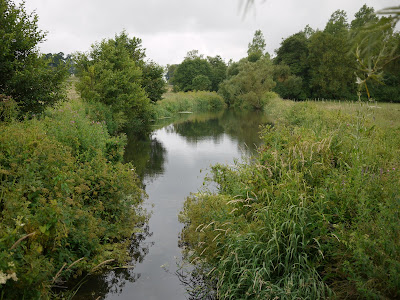Another walk in the series with our friends from Chichester. This one starts at the Hambledon Church (St Peter of 1846). We were very taken with the tile-hung barn to the left of the church.

And immediately on the right as we began our walk was a lime kiln, which a helpful notice explained was in use up to the 19th century.

We struck out across fields and through woodland to reach the viewpoint of the oddly named Hydon’s Ball (179m).
The view towards Black Down was impressive. A vast concrete seat provided the information that this land had been given to the National Trust by Octavia Hill, of its founders. It would have been nice if it had been renamed Octavia Hill Hill.

From here, the route took us through woodland, along a short stretch of road and then down one side of Juniper Valley and up the other to reach the hamlet of Hascombe. We first noticed the pretty pond ...

... and then the the church of St Peter, one of Simon Jenkins’s 1000 best churches. It dates from 1864 and is by Henry Woodyer. The outside is pleasant but unremarkable ...

... , but the decoration of the inside is just wonderful. The chancel arch and the apse beyond are fabulous; the beams of the roof of the apse are magnificently gilded to create an almost abstract pattern. Pevsner describes the church as being "worth a very special look" and thinks the decoration of the apse produces "an ornamental effect as rich as anything that Art Nouveau produced".

Next up was an excellent lunch at the White Horse pub. Afterwards we headed across a field to enter the Hurtwood, and eschewed the official route to pass close to the precipice at Breakneck Hill. The views were mostly obscured by trees, but eventually we were rewarded by a gap where there was a bench and fine view towards Black Down, near Haslemere.

We now followed part of the Greensand Way back to Hambledon.
From: Walks in Surrey and Sussex (Pathfinder Guides).
Distance: 6.5 miles.
Map: Explorer 133 (Haslemere and Petersfield) and 145 (Guildford and Farnham).
Conditions: slightly showery at first, but then just cloudy, mild.
Rating: Three and a half stars. Very varied, with a surprising number of climbs, but perhaps a bit enclosed.
Flower of the day
This impressive Cardoon caught the eye.







































